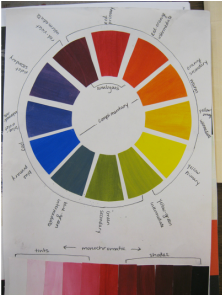Vocab from Chapter 5
|
Warm colors
Cool colors Value Spectrum Hue Primary colors Secondary colors |
Intermediate colors
Complementary colors Monochromatic Intensity Tints Shades Color harmonies Analogous |
how to paint a color wheel
HOw to paint tints and shades
check out this cool website with an interactive color wheel!!!
Click on the word "this" above.
|
Color Theory- Mixing ColorsMaking a Color Wheel
Task 1
Monochromatic Tints and Shades Task 2
Task 3
Assessment will be based on how well your colors are mixed for your color wheel and monochromatic scale, craftsmanship and correct labeling. |

